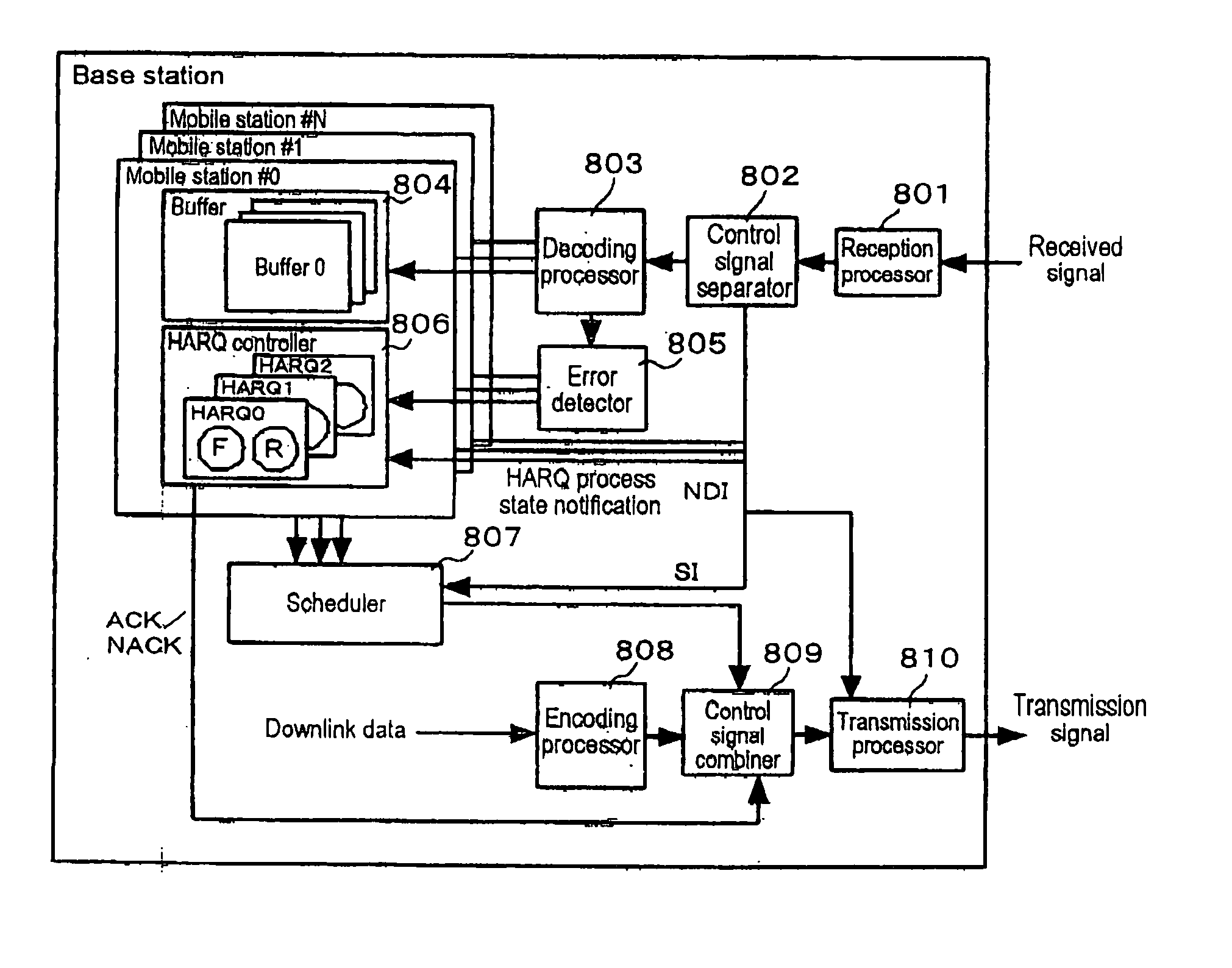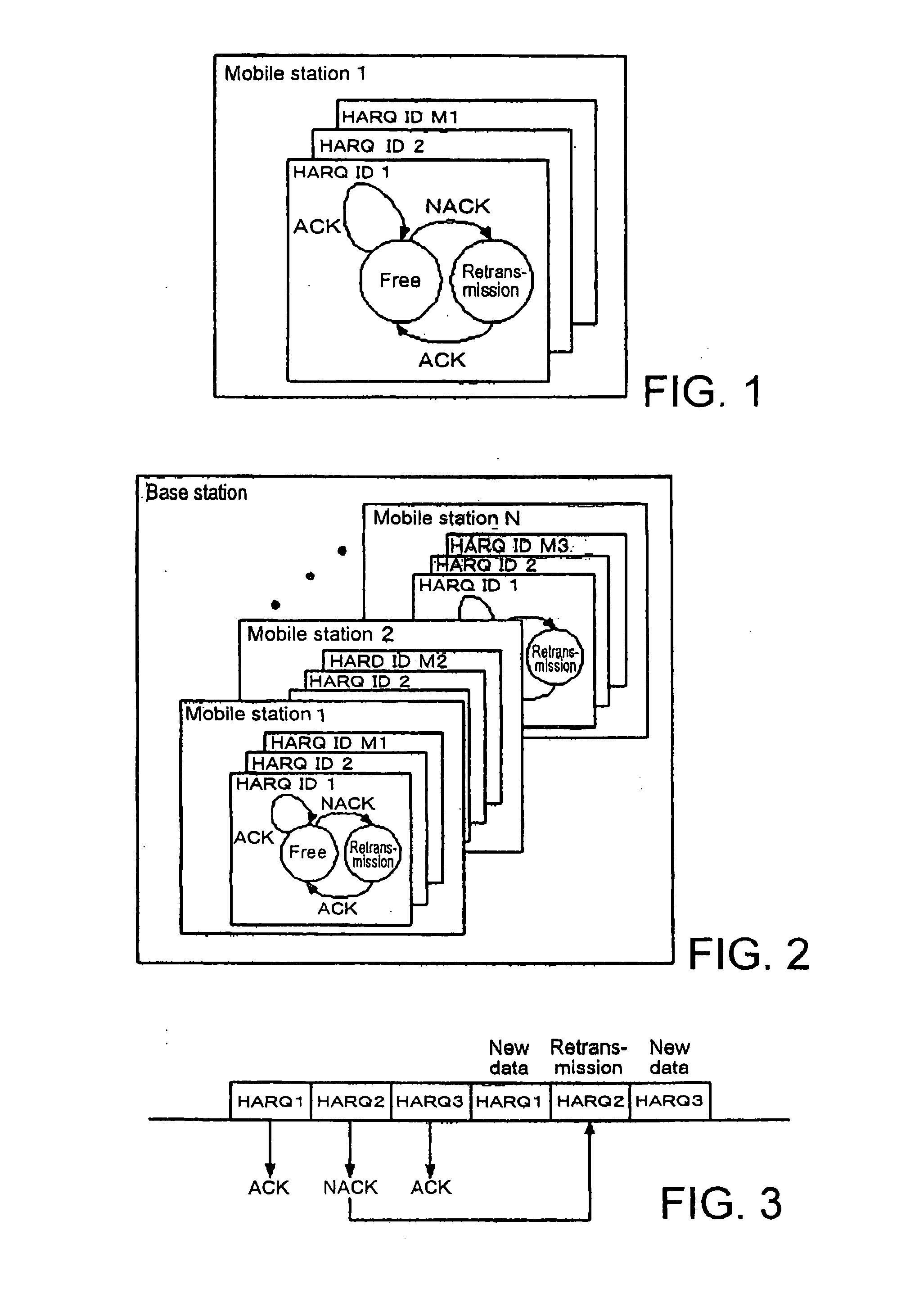Communication Control Method, Radio Communication System, Base Station, and Mobile Station
a radio communication system and control method technology, applied in the direction of digital transmission, wireless communication, transmission path sub-channel allocation, etc., can solve the problems of inability to carry out appropriate scheduling, inability to transmit the ndi that is to be transmitted together with the data block, and deteriorating throughput, so as to improve system throughput and user throughput, improve user throughput, and reduce the transmission delay of data packets
- Summary
- Abstract
- Description
- Claims
- Application Information
AI Technical Summary
Benefits of technology
Problems solved by technology
Method used
Image
Examples
first embodiment
[0107]Explanation next regards the communication control method according to the first embodiment.
[0108]In the first embodiment, the use of time / transmission rate scheduling and the use of synchronous transmission for HARQ will be assumed. It is further assumed that, regarding retransmissions, the base station will command, i.e., a base station-controlled retransmission method will be used.
[0109]In the present embodiment, a configuration is adopted in which TFCI is used to enable communication of the HARQ process states of mobile stations. TFCI are bit sequences indicating the TFC that prescribe the transmission data format, and of these bit sequences, two will be defined as the free state notification and the retransmission state notification. The use of five-bit TFCI is here assumed as shown in the following table. In other words, TFCI0 is defined as the free state and TFCI1 is defined as the retransmission state.
TABLE 1TFCI ClassificationBit SequenceDefinitionTFCI000000Free state...
second embodiment
[0144]Explanation next regards the communication control method according to the second embodiment.
[0145]The second embodiment assumes the use of time scheduling and the use of asynchronous transmission for HARQ. In addition, mobile stations are assumed to make determinations regarding retransmissions. In other words, the use of a spontaneous retransmission method will be assumed. As in the first embodiment, this second embodiment also uses TFCI to transmit HARQ process state notifications. More specifically, TFCI0 is defined as the free state, and & TFCI1 is defined as the retransmission state.
[0146]A mobile station uses a HARQ process state notification in the following cases:
[0147](a) when the mobile station has received ACK, and further, the mobile station has no data in its buffer that should be transmitted;
[0148](b) when the mobile station has received NACK, and further, after receiving the NACK, the maximum transmission rate is continuously lower than the required transmissio...
third embodiment
[0173]Explanation next regards the communication control method of the third embodiment.
[0174]As in the first embodiment, in the third embodiment, the use of time / transmission rate scheduling is assumed, and HARQ is assumed to employ synchronous transmission. Further, base stations are assumed to command regarding retransmissions. In other words, the use of a base station-controlled retransmission method will be assumed.
[0175]In the third embodiment, when a mobile station receives NACK from the scheduling base station and receives ACK from another SHO base station, and moreover, does not have data in its buffer, the mobile station transmits a “no data” notification as the HARQ process state notification. TFCI0 is used as the “no data” notification, and upon receiving TFCI0 from a mobile station, a base station corrects the relevant HARQ process to the free state and does not assign retransmission resources.
[0176]The adoption of the above-described “no data” notification enables a ci...
PUM
 Login to View More
Login to View More Abstract
Description
Claims
Application Information
 Login to View More
Login to View More - R&D
- Intellectual Property
- Life Sciences
- Materials
- Tech Scout
- Unparalleled Data Quality
- Higher Quality Content
- 60% Fewer Hallucinations
Browse by: Latest US Patents, China's latest patents, Technical Efficacy Thesaurus, Application Domain, Technology Topic, Popular Technical Reports.
© 2025 PatSnap. All rights reserved.Legal|Privacy policy|Modern Slavery Act Transparency Statement|Sitemap|About US| Contact US: help@patsnap.com



